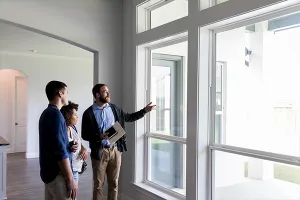
When it comes to what home buyers want, detached single-family homes continue to be a hot commodity.
And while buyers are looking for larger properties, it’s not a whole lot more than what they currently have, according to the National Association of Home Builders.
In 2023, home buyers had a median of 1,802 square feet in their current home and wanted a median of 2,067 square feet, NAHB found in the latest edition of its “What Buyers Really Want” survey. That’s about 200 square feet—the size of a 14-by-14 bedroom—less than what they wanted two decades ago.

“Among the possible explanations behind the shift in size preferences are high home and land prices and the desire to save on heating and cooling costs,” NAHB’s report says. The association found that 35% of buyers would be willing to take a smaller home in exchange for a better price and were most willing to compromise on space for a home office or dining room. The median size of newly constructed homes is also shrinking to match that demand.
Aside from the sticker shock of larger homes, changes in household composition could also be driving down the size of homes, says NAR Deputy Chief Economist Jessica Lautz.
“We know that there are more single households and single home buyers than we have seen historically—about a third of recent home buyers are single, so they may need or desire a smaller property,” Lautz says. She adds that the number of households with children is at an all-time low. “So, they may not need that three-bedroom, two-bath home. They may really want a two-bedroom, one-bath home, and that’s not necessarily the inventory that’s out there. So, home builders are starting to be attuned to that and building smaller properties where they can.”
While some might be quick to pin the trend on an aging demographic looking to downsize, the numbers don’t support that notion.
“For 55- to 74-year-olds, they are ‘downsizing’ 100 square feet—if we can even consider that fully downsizing,” Lautz says. “That’s almost a one-to-one trade. And then for those 75 years and older, they're downsizing 200 square feet.”
According to Census data, the median square footage of new single-family units peaked in 2015 at 2,466 square feet and dropped to 2,177 in 2023.

In the western part of the country, the size of new builds peaked in 2014 and dropped 370 square feet in 2023. Randy Ginn, a broker with NW Builders Group, a part of Windermere Real Estate, in Bellevue, Wash., says that’s generally not the direction builders want.
“What's happening is jurisdictions [in the Seattle region] are imposing rules and lot coverage restrictions,” Ginn says. “Effectively, what's happening is the cities are preserving more trees. They’re preserving larger setbacks. They're shrinking the amount of lot that we can cover with a new house, and the builders, therefore, are being forced into smaller houses. They don't want to build smaller houses, and quite frankly, the market doesn't necessarily want smaller houses.”
Ginn works primarily in new construction and says he believes local policies, like tree ordinances, are impacting home sizes more than a shift in house hunters’ preferences.
“In my experience, everybody is trying to buy as big of a home as they can afford in their comfort zone,” Ginn says. “I rarely have people come in saying, ‘I want to get the smallest house out of the group.’ If you look at the average deal we do and the average loan, they're buying 95% of what they can afford[EB1] and, in most cases, 100%.”
When compared to new builds, NAR data shows previously owned homes purchased in 2024 were slightly smaller, at about 1,800 square feet.


That makes sense, Lautz says, because generally, existing homes in the market today were built during a time when properties were smaller. The typical home bought in 2023pdf was built in 1985, and the typical home bought in 2024pdf was built in 1994.
While homes are measured in square footage, there is a lot of space that isn’t counted in that measurement, such as unfinished basements, garages and pools.
During the COVID-19 pandemic and the early days of lockdown, many homeowners took comfort in the freedom to enjoy their own private outdoor sanctuaries on their porches, decks or in their gardens.
Ginn agrees that the feeling of openness comes in different forms, giving an example of a 3,500-square-foot home with flat ceilings throughout the first floor, or a house that’s 3,200 square feet with a 20-foot ceiling and tall windows.
“Space is a lot more important than square footage to a lot of buyers,” he says.
So how much space do you need to call home? That's in the eye of the beholder.









